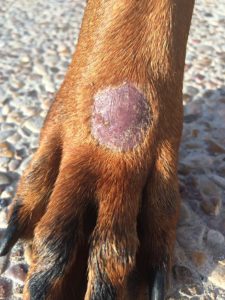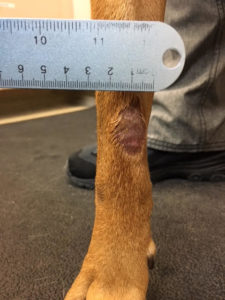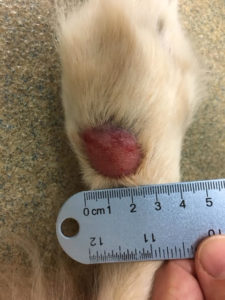Acral lick granuloma, or acral lick dermatitis (ALD), is a disorder which occurs when a pet continuously licks an area of skin. Pets with acral lick granuloma develop painful, ulcerated wounds that can become progressively worse if left untreated.
Causes of Acral Lick Granuloma
Acral lick granuloma is caused by excessive licking of the skin. Underlying causes of this behavior include obsessive compulsive disorder (OCD) and other psychological factors such as boredom, separation anxiety, and stress.
Pets may also lick their skin excessively in response to pain and irritation causes by allergies, infection, parasites, trauma, or health conditions such as osteoarthritis.
Symptoms of Acral Lick Granuloma
The first sign your pet is suffering from acral lick granuloma is compulsive licking or chewing at a particular area of skin. The most common site of acral lick granuloma is the front side of the forelimbs.
Other symptoms of acral lick granuloma include redness and inflammation of the affected area, thickened and ulcerated skin, hair loss, and secondary fungal or bacterial infections. Please take your pet to the veterinarian for a checkup if you notice any of these symptoms.
Diagnosis of Acral Lick Granuloma
Your veterinarian will ask you a series of questions about the onset of symptoms and perform a physical examination of your pet to check for signs of acral lick granuloma. Examining your pet will also help identify any potential underlying causes of their condition.
Additional tests used to confirm a diagnosis of acral lick granuloma include skin scrapings, biopsies, and cultures of affected tissues. X-rays may also be used to rule out underlying causes such as osteoarthritis or trauma.
Treatment of Acral Lick Granuloma
Treatment of acral lick granuloma will depend on the underlying cause of the condition. Treatment may include dietary changes to combat food allergies, increased exercise and mental stimulation to minimize psychological issues, or medications to treat underlying health conditions contributing to excessive licking.
Your veterinarian may also prescribe medications such as nonsteroidal anti-inflammatory drugs (NSAIDs) or antibiotics to manage the symptoms of acral lick granuloma.
It is very important that your pet’s wounds are protected from licking, biting, or scratching during recovery to prevent infection. For this reason, pets should wear an Elizabethan collar (cone) around their neck until their wounds have fully healed.
Cones are designed to be left on at all times, and we recommend against removing them to reduce the risk of wounds becoming damaged or infected. Keeping the cone on will also allow your pet to get used to it more easily.
Prevention of Acral Lick Granuloma
Pet owners can minimize the risk of their pet developing acral lick granuloma by providing plenty of exercise and feeding a balanced, nutritious diet to support the immune system.
It is also important to keep your pet clean and well-groomed to help prevent skin irritation and inflammation. Finally, check your pet regularly for symptoms of acral lick granuloma or other skin problems and schedule routine health checkups with your veterinarian.




